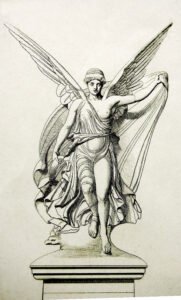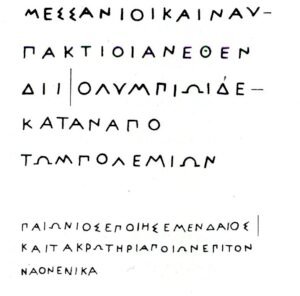Nike of Paionios
The work of the famous sculptor Paeonios from Mendi in Chalkidiki, this statue, made of Parian marble, is the personification of Victory descending from the sky to triumphantly announce a military victory.
It was discovered in 1875, during the first year of the German excavations at Olympia, fallen in front of its pedestal.
The goddess is depicted as an ethereal female figure, with spread wings, having just arrived on earth flying from Olympus. She steps with her right foot on an eagle, the head of which is clearly visible, while its wings are now lost.
The work was dedicated to Zeus and was placed at a key point in the Sacred Altis (the sanctuary in Olympia) at a distance of only 30m from the SE corner of God’s temple as a reminder of the martial side of his cult.
The statue’s pedestal had a total height of 8.81m up to the top, consisting of twelve blocks of triangular shape. With the total height of the statue taken into account, which reached 3m. up to the edge of the wings, the work (statue and base) measured nearly 10.92m in height.
The inscriptions that survived on the third triangular stone from the bottom are valuable testimonies about the reason for commissioning the work, and about its creator.
- ΜΕΣΣΑΝΙΟΙ ΚΑΙ ΝΑΥΠΑΚΤΙΟΙ ΑΝΕΘΕΝ ΔΙΙ ΟΛΥΜΠΙΩΙ ΔΕΚΑΤΑΝ ΑΠΟ ΤΩΝ ΠΟΛΕΜΙΩΝ – The Messenians and Nafpaktians assigned, as a tenth of the spoils of war, to Olympia’ s Zeus. According to the inscription, Nike was a votive offering to Zeus of Olympia, on behalf of the Messenians and Naupaktians from the spoils of a victorious war, probably after their victory against the powerful army of the Lacedaemonians in a battle during the tenth year of the Peloponnesian war, in 421 BC
- Immediately below there is an inscription in smaller letters, informing that the statue was created by the sculptor Paionios from Mendi in Halkidiki, who was also the creator of the edifices of the Temple of Zeus, after he had emerged as the winner in a competition. The inscription states specifically: ΠΑΙΩΝΙΟΣ ΕΠΟΙΗΣΕ ΜΕΝΔΑΙΟΣ ΚΑΙ ΤΑ ΑΚΡΩΤΗΡΙΑ ΠΟΙΩΝ ΕΠΙ ΤΟΝ ΝΑΟΝ ΕΝΙΚΑ.
Paeonios, in an admirable way and with unparalleled skill, succeeded in creating a flying divine figure which he depicts landing with a strong inclination of the torso forward, balancing this posture at the back with her robe swelling from the resistance of the wind, which today’s viewer is invited to imagine due to the losses that the work has suffered and especially with the lower part of the statue with the folds of the tunic.
Αpart from the fluttering robe, the wings, the neck, and the forearms of both hands, from the figure are missing the palm or laurel branch as well, or even the ribbon that she was holding, as evidenced by depictions on coins of the time.
Nike was painted with red color on her tunic, a gold belt around her waist, while her head was also decorated with a gold band.
Even with the serious losses and the damage it has suffered, the statue still impresses today, being one of the masterpieces of ancient sculpture, a representative sample of the so-called “rich style” of art (430/420-400/390 BC), a period in which greater freedom of movement, grace, and lyricism are observed in the forms.





